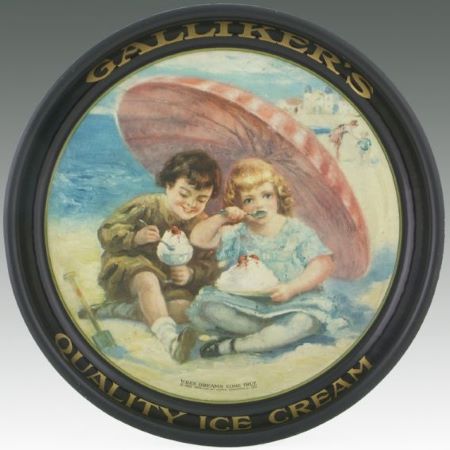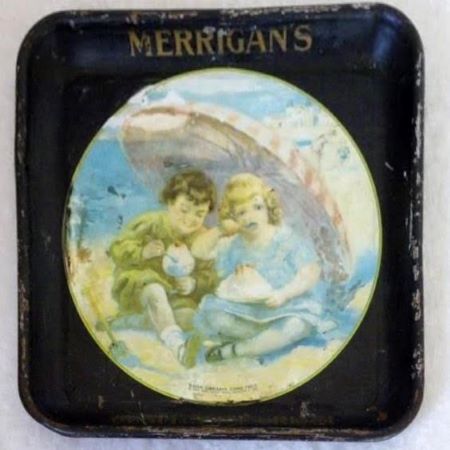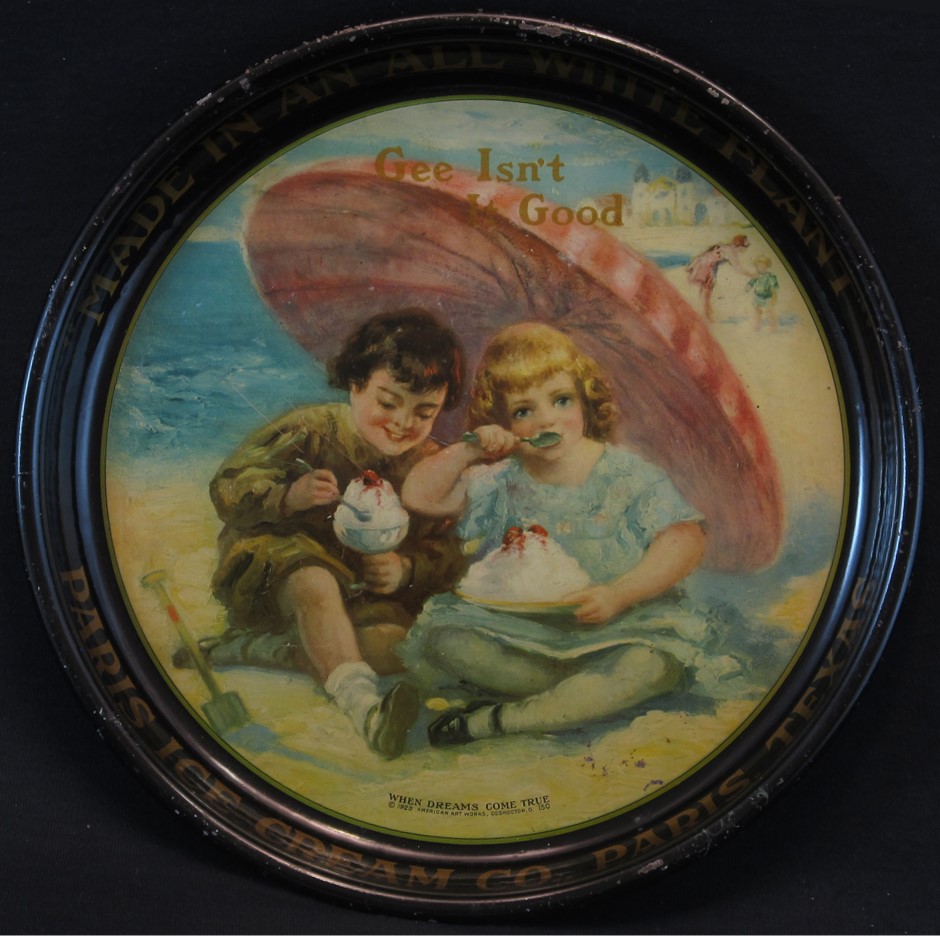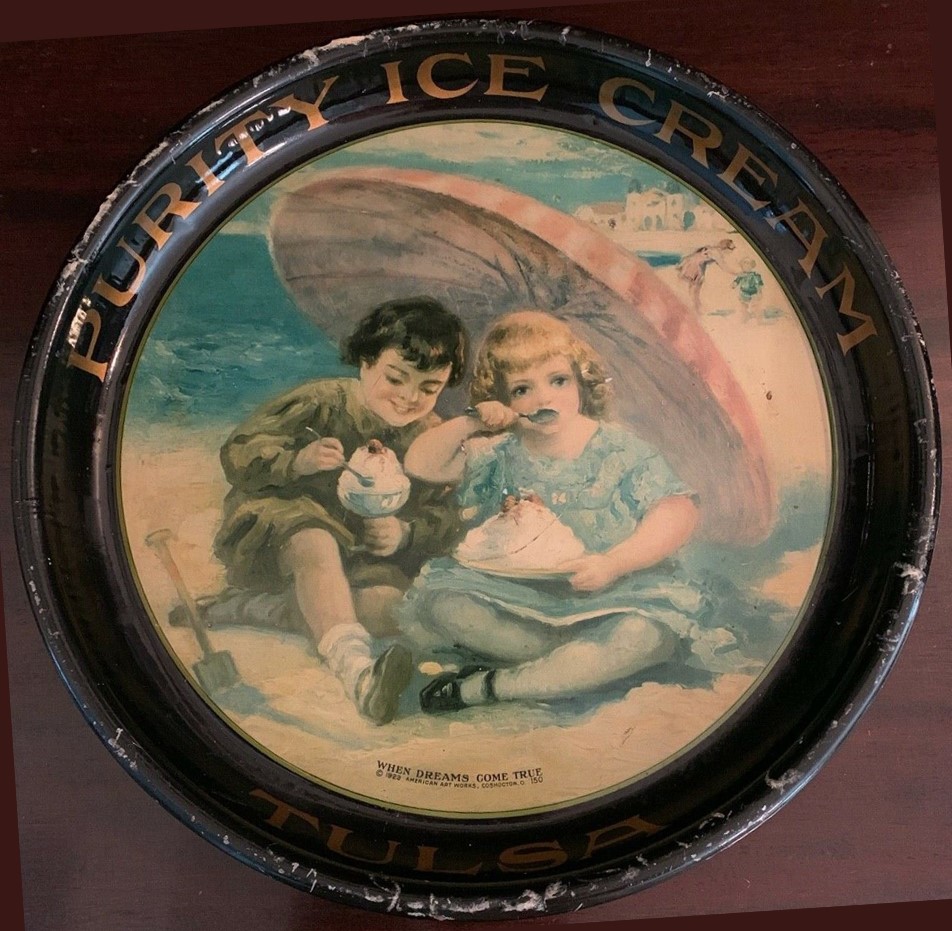American Art Works: No. 150 "When Dreams Come True"
Size: 13" Round
13.5" x 13.5" Square
Type: Pie
Scarcity: Uncommon
Value: $$$ to $$$$
Condition & Brewer Dependent


Two years passed between stock design No. 149 and the release of No. 150 "When Dreams Come True," a strong indication that the driving force or demand for trays had come from the breweries (and to a lesser extent the liquor trade). While there had been advertisers from a broad swath of other industries and trades that used trays and stock designs, that had never been a large part of American Art Works tray business. With prohibition the vast majority of the demand for trays ceased. While ice cream may have been a sort of substitute product for the consumer, it did not have the volume of demand for trays. While some other tray manufacturers (Haeusermann and Kaufmann & Strauss) appear to have gone out of the tray making business, American Art Works, H.D. Beach and Charles W. Shonk (by now part of American Can Co.) appear to have shifted their focus to other product lines, perhaps explaining Adolph Sahling’s move from the Art Department to the Display Department in 1921 (as discussed in No. 149).
This is the only design from Meek/American Art Works that depicts a beach scene. In modern America, vacationing at the beach may be one of the most popular summer destinations, but historically this is a relatively modern development. Up until the 19th century, the seashore was considered a dangerous place and was the province of fishermen and others who made their livelihood from the sea. European elites began touting the curative qualities of fresh air, exercise and sea bathing. Especially in Britain, home of the Industrial Revolution, aristocrats and intellectuals became preoccupied with their own health and hygiene. They viewed workers, whose numbers were multiplying in factories and new industrial towns, as strengthened through labor. By comparison, the upper classes seemed fragile and effete: lacking in physical prowess and destined for decline. The notion of the “restorative sea” was born.
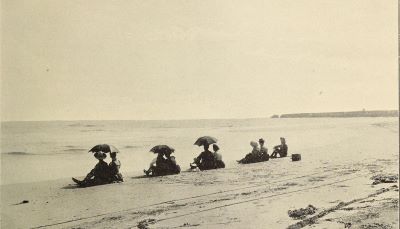
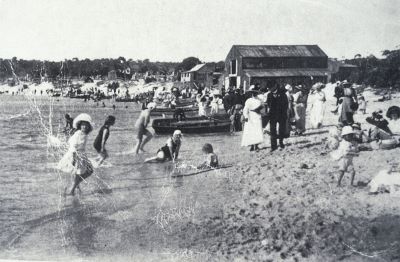
Physicians prescribed a plunge into chilly waters to invigorate and enliven. The first seaside resort opened on England’s eastern shore in the tiny town of Scarborough near York. In America, Puritan ideals discouraged the whole concept of vacation; taking time off work for anything but the sabbath was considered sinful and really didn’t change until the era of organized labor in the later 19th and early 20th century.
Oddly, the children in this design are fully clothed, including wearing shoes, and not attired in anything resembling beachwear. Equally incongruous is eating ice cream in dishes on a beach, especially such a large portion as the girl has. While her dish is not recognizable as any specific ice cream dish, the boy clearly has an ice cream sundae. Although it’s agreed that the sundae was invented in the late 19th century in America and is generally composed of multiple scoops of ice cream, chocolate syrup, and is topped with a maraschino cherry, there is disagreement on who invented it and where. Two possible explanations are:
- The owner of a soda fountain and ice cream parlor in Two Rivers, Wisconsin had a customer ask for ice cream with chocolate syrup on top, which was only used to flavor sodas. They began serving it on Sundays for a nickel but added it to the regular menu after a young girl asked for the dessert during the week, asking if they could ‘pretend it was Sunday.
- On a Sunday afternoon in 1892, Reverend John M. Scott of a local church came to the Platt & Colt drugstore in Ithaca, NY after service for a refreshment. A friend asked his fountain clerk for two bowls of ice cream, adding cherry syrup and a candied cherry before giving it to the Reverend. The two men loved the dish so much that they named it the ‘Cherry Sunday’ after the day it was created. Evidence shows an advertisement for Platt’s sundae in the Ithaca Daily Journal of October 5, 1892.
The two most frequently encountered advertisers using this design are Merrigan’s Ice Cream and Galliker’s Ice Cream. Amazingly, Galliker’s Dairy Company is still in business, headquartered in Johnstown, Pennsylvania since 1914. Ice cream was their only product until they started producing milk in 1925 in response to competition within the ice cream business https://www.gallikers.com/ice-cream/
Sahling's Design Notes
By this time Sahling had left the Art Department and there are no more entries in his workbook.
Size, Shape and Message Placement
Examples we have seen have primarily been concave pies, with some square designs; the latter are the style with the round image on the square tray, not the ones where the design covers the entire face of the tray. Rims are black with gold advertising text. None have advertising on the face of the tray.
Hager & Price
Hager stopped commenting on specific trays after No. 136, but he does include this design in his date of introduction table (1923), and he includes it in his catalog with the proper stock number (No. 150). It is the very last design he includes in either the table or his catalog. The Galliker and Merrigan examples seem to be the most common. Most examples, regardless of advertiser, are in the double figures with the odd tray or two reaching low three figures. Two exceptional examples, both of which were from Galliker, reached $600 and $1,400 respectively.

